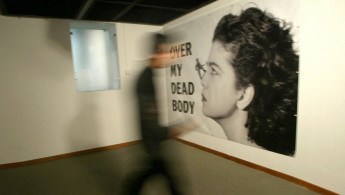Keeping the Nakba memory alive through art
Since the Nakba, 67 years ago, representations of the Palestinian tragedy have permeated the works of many Palestinian and Arab artists.
Palestinian artists such as Ismail Shammout (1930-2006), and his contemporary, Abdul Hay Mosallam Zarara, are among the most prominent names in Arab memory of artists from the Nakba generation.
A recurrent motif prevalent in both men's work is the Palestinian countryside, presented through women's traditional dress, rural customs, weddings, and harvest rituals.
Yet another motif that always figured in their works was the Nakba, the memory of which both Shammout and Mosallam Zarara always wanted to keep alive, especially in paintings such as Where To, Here was my Father, and Thirst Along the Road from Lod to Ramla (Shammout).
In effect, Mosallam Zarara went beyond painting the Nakba, to giving an oral testimony of its events, recounting details of how he and his family escaped with their lives from the village of al-Dawayima. The quintessentially rural artist always sought to bear witness of an event that marked a turning point in the history of the entire region, both in person and in his works.
In addition to Shammout and Mosallam Zarara's works, symbolist and abstract schools of arts emerged with artists such as Kamal Balata (born 1943), Juliana Sarouphim (b. 1934), Samia Halabi (b. 1936), and others, all belonging to the Nakba generation.
The life and works of Palestinian artist Mona Hatoum (b. 1952) of the post-Nakba wave in particular deserves pause.
Born in Lebanon to displaced Palestinian parents, Hatoum produced a series of conceptual installations where her identity as a Palestinian, Arab, and a woman were inseparably bound together.
| The Palestinian cause arguably shaped an artistic identity deeply connected to everything political and humanitarian. |
Younger Palestinian artists of interest include Sharif Waked (b. 1964), Rana Bishara (b. 1971), Steve Sabella (b. 1975), Hani Zurob (b. 1976), Mohammed Hawajri (b. 1976), and Abdul Rahman Katanani (b.1983).
The Palestinian cause arguably shaped an artistic identity with a deep connection to everything political and humanitarian beyond Palestine's borders.
"Justice cannot become humane and real until the Palestinian people regain their land and their rights," said Iraqi artist Dia al-Azzawi.
Azzawi, like many other Arab artists who painted the Palestinian tragedy, is behind the mural Sabra and Shatila, which some have called a Palestinian version of Pablo Picasso's famous anti-war painting Guernica.
Then What? a painting by Syrian artist Louay Kayali (1933-1978) belongs to this generation's work. The painting shows pale women covered in black, reminiscent of Euripedes' Trojan women, surrounding a man carrying a defeated expression. Everyone in the canvas looks emaciated and exhausted, as though they had been forced to march long distances and leave their entire lives behind.
The same goes for the work of his contemporary, Syrian artist Fateh al-Moudarres (1922-1999). One of his masterpieces was part of a series inspired by Palestine, The Martyrs' Mothers, which he painted in the first year of the Nakba - known as "the catastrophe".
Palestine also provided the artistic debut for many artists. Some even summoned the theme of Palestine as early as their university graduation projects.
Syrian sculptor Zuhair Dabbagh's (b. 1953) graduation project was about the massacre of Tal al-Zaatar (1976). Both Sculptor Rabih al-Akhras (b. 1951) and Syrian artist Youssef Abdelke (b. 1951) produced artworks on the same topic, the latter with the three Black September paintings that were also his graduation project.
The three-piece work features, in the central painting, a general/monster-like figure in front of tanks and cannons rolling over corpses of people and horses. In the two side paintings, there is a crowd of people protesting and resisting.
Jenin 2002, by Syrian sculptor Assem al-Basha (b. 1948), is a sculpture of human hands reminiscent of limbs extending from the rubble of bombarded homes. The work was completed in solidarity with the Palestinians of the Jenin refugee camp in the West Bank, which faced heavy bombardment and a brutal invasion by Israeli troops during the peak of the second intifada.
More recently, Palestinian-Syrian sculptor Zaki Sallam produced an artwork titled The Nakba of 2012, inspired by the ordeal of the residents of the Yarmouk refugee camp in Syria.
Ever the refugee, Sallam made the life-sized statue in Algeria - his current place of asylum after he and his family left Yarmouk.
This article is an edited translation from our Arabic edition.



